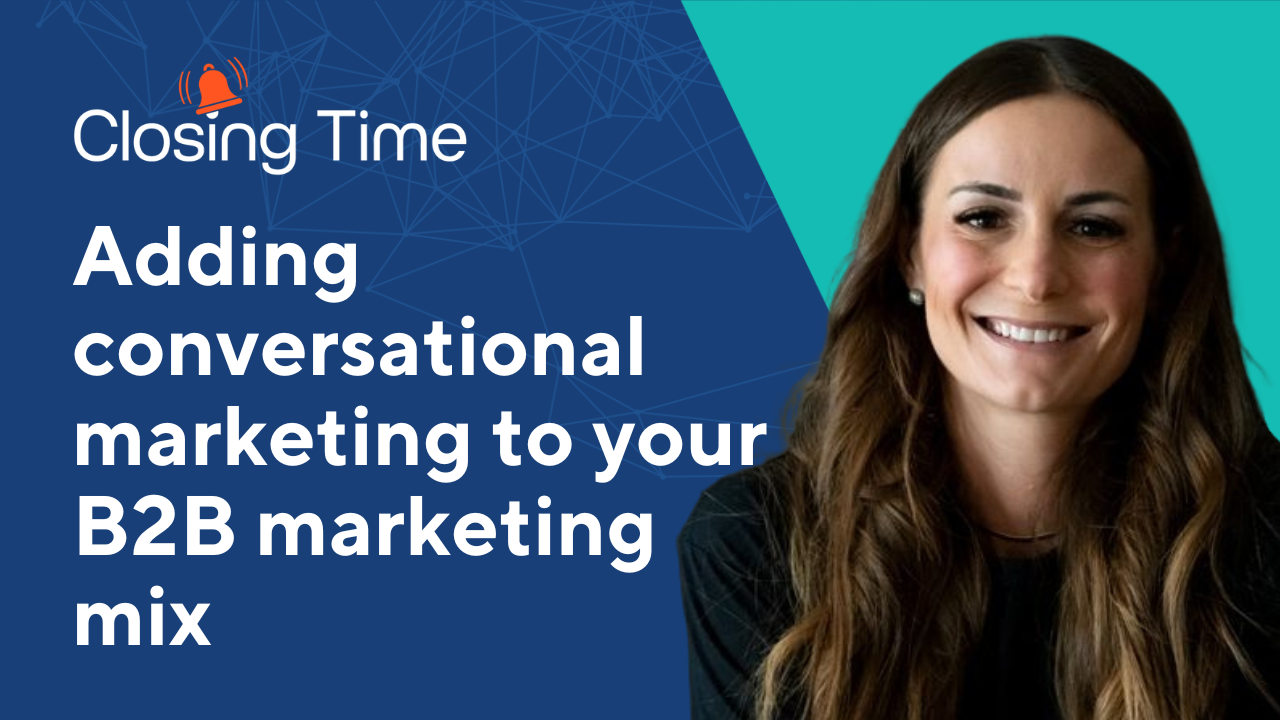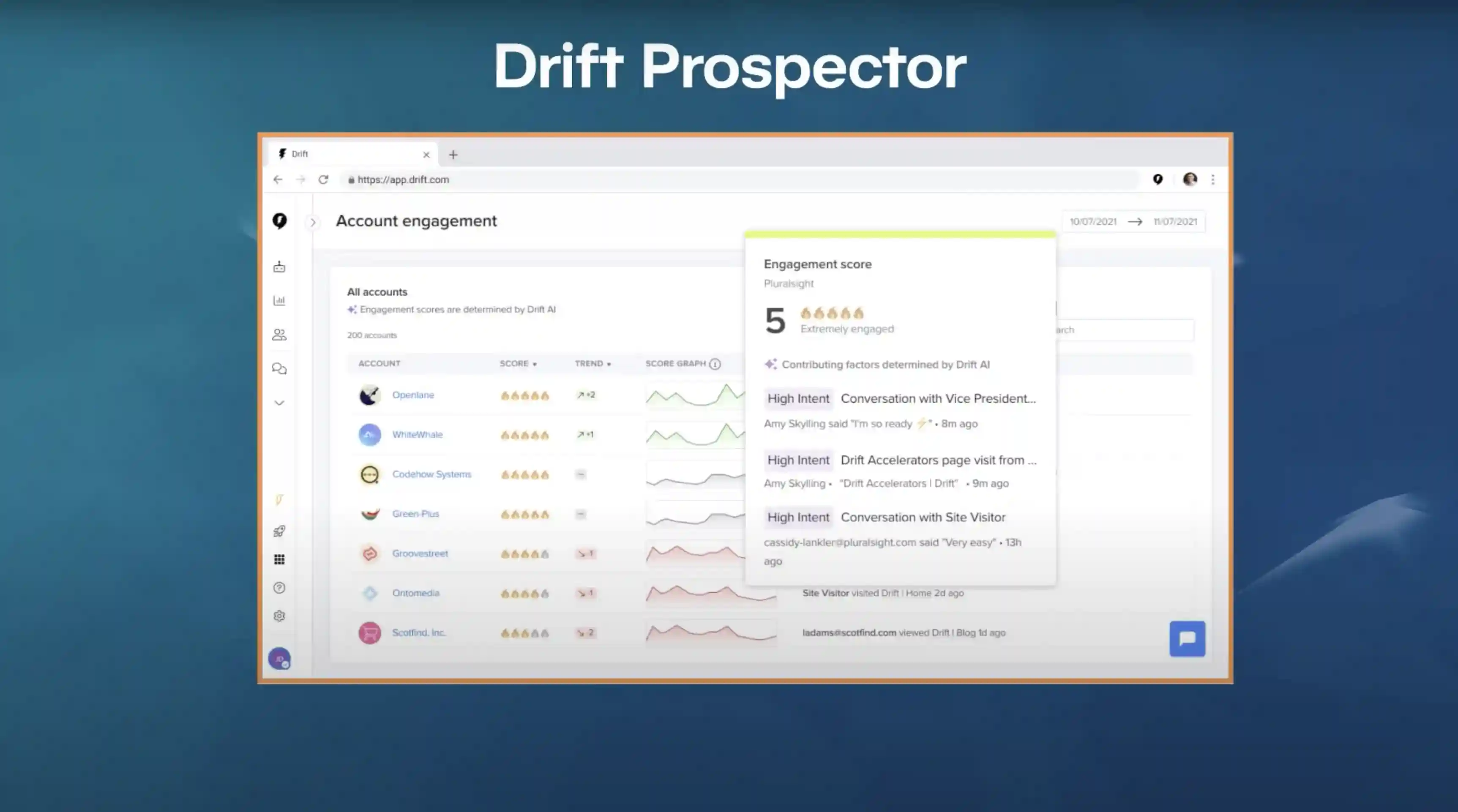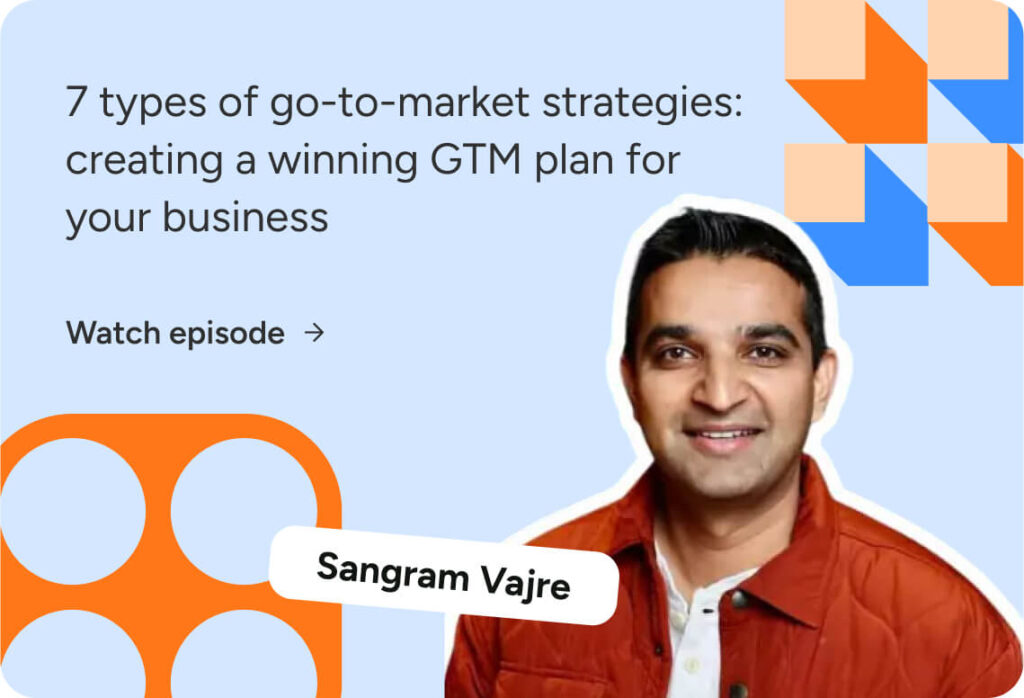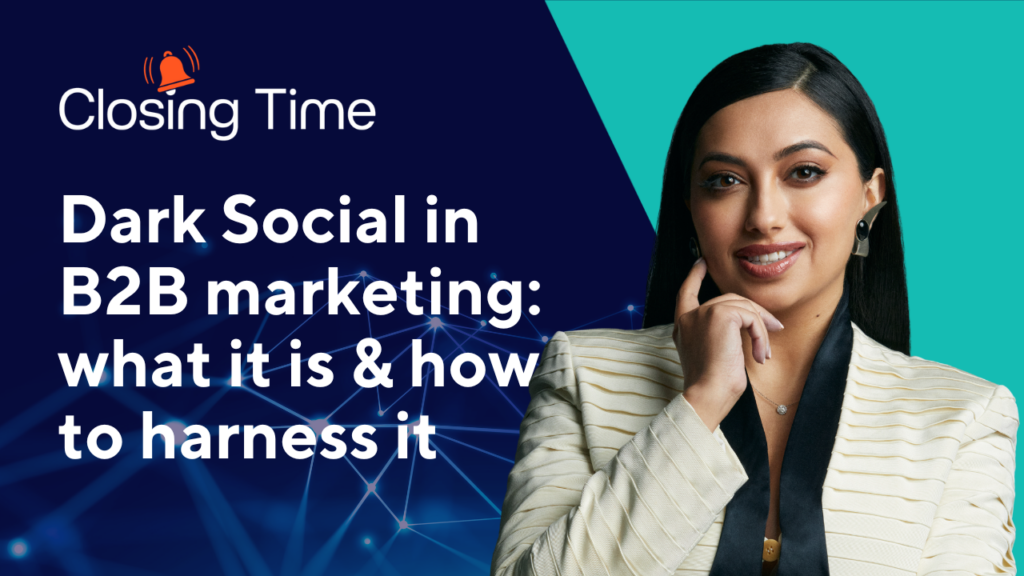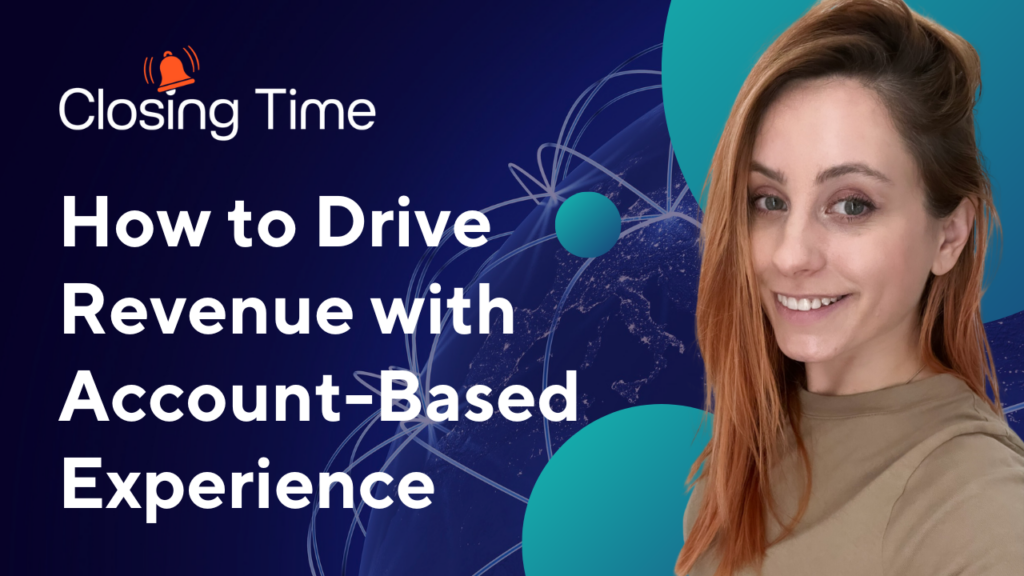How long will the average prospect wait when sending in a chat?
We’re talking all about conversational marketing in this episode of Closing Time.
And Chip House, CMO at Insightly.
Welcome to Closing Time, the show for go-to-market leaders.
I’m joined today by Katie Foote.
She’s the CMO of Drift, a fast growing. SaaS business in the conversation cloud space.
Welcome, Katie.
Thank you, Chip. So happy to be here.
Yeah, it’s great to have you back.
So Katie, you know, we chatted in the last episode of Closing Time a bit about how marketing
and sales teams can optimize you know, their chat
bot for leads, for engagement, for timing.
But when you have a buyer that’s finally engaging with you,
they want sort of instant gratification.
And you talked about
a great metaphor of a customer walking into a store and
there’s nobody around.
And so they get to leave a post-it note,. I think was your example.
So you know, customers in a modern digital age
right now have the chance to engage with companies kind of immediately.
And they expect that immediate gratification.
So what’s your experience there at Drift and how that’s changed and evolved
and maybe even heightened in the last couple of years during the pandemic?
Yeah. So I guess a couple of thoughts.
Sometimes we talk about buyers at organizations as this mythical creature that’s far and away,
but really it’s just people like you and me,
as CMOs, we purchase technology and tools all the time.
And so we want and expect the same instant gratification in those B2B experiences
than we would if we’re ordering on DoorDash or visiting Amazon or going on TikTok.
So I think it’s important to keep that in mind when we’re talking about response times
and what buyers expect.
Put yourself in the shoes of that buyer because we are people buying from people
and if we’re to carry out that analogy of walking to and into a store.
Your website is really the front door to your store.
And, you know, we know that
I think the most recent stat that I saw was 81% of buyers
will choose a brand time and time again if they have a positive digital experience.
But on the flip side of that, you don’t have a lot of time to make a good first impression.
Buyers in a B2B cycle will give sales reps about 5% of their time in total.
We’re very educated.
We’re doing research on our own, so by the time we arrive at the front door,
of that store on a website, we typically have very specific intent.
We are ready to engage with someone and we find on average that if
I open up a live chat and someone’s not there to greet me or meet my needs, I’m going to bounce
pretty quickly.
Within 15 seconds I start to leave.
By 30 seconds your chance is almost over.
So as a best practice, we want to respond to an inbound chat
within 5 seconds of someone arriving at the front door of your store.
Makes good sense.
So when you’re actually physically in a store, sometimes it’s helpful to have people walk by
to see how you’re doing.
And sometimes it can be border on annoying if they do it too quickly.
Or too often.
So how does that play in the conversational marketing world?
That’s such a great point.
We really want to our premise as an organization since we were founded in 2016 has always been
to empower the buyer, put the buyer at the center of everything that you’re doing
and really put the ball in his or her court.
So if I come inbound and I engage with a chat bot initially, you can have really strong hooks
or questions to figure out exactly what that consumer is looking for.
Sometimes they just want to download a piece of content. Great.
We’re there to provide that.
Sometimes they want to talk to an actual seller about pricing and packaging.
We want to be able to engage appropriately there.
So to be able to develop the right response and the next best action.
You need to have a clear marketing strategy.. You need to when you’re driving,
there needs to be clear calls to action for why someone might come to your website
and what they might be doing, and need to make sure internally that your sales
organization understands all of the messages that you have out at market, what your strategy is
so that they can catch the ball when that individual comes to the site.
So if I put a chat bot from Drift on my website, Katie
what percentage of visitors should I expect will engage with it?
Yeah, you know, it varies by industry, it varies by use case and how they arrived at your site.
We do know typically though, that
when someone engages with a chat bot, at least in our own instance of Drift usage,
we see that those chats turn into qualified really strong opportunities at a rate of 75%.
So it’s the highest lead converting source that we have across our entire marketing mix.
And so
when done well, those conversion rates are just incredibly high.
As a marketer, you know, that’s, that’s just a really great lead source
and it’s a warm lead for an organization to engage with.
That’s super helpful.
But let’s pivot a little bit more and drill into the customer experience.
You know, so if I’m already doing business with a company, and I start engaging
with the conversational tools on the website, you know what, again, what
what are my expectations for speed?
Are they any different than are buyer’s and a prospect’s?
They might even be more heightened?
Hey, I’m a customer. Hello.
I have a problem.
Can you please help me?
And you know, if it’s 2 a.m.
where your company is, but it’s in the middle of the day where mine
is, certainly that’s maybe even more heightened.
So I would guess in a global digital world, companies have to figure that out, right?
Absolutely.
And we talk a lot about, our technology really makes that human connection
and relationship and conversation possible.
And so you have to be willing to follow the sun
globally as an organization to be able to meet that demand.
And so that’s a best practice that we institute that we talk to a lot of our customers about,
depending on where they are on that maturity curve.
We don’t see a lot of variance in response times across someone who’s coming inbound
through marketing, an opportunity, or existing customer who wants to engage with sales
or their account rep or even someone who’s looking for service and support on the product.
I think one exception to that rule is potentially deflection.
So if you have someone coming to your site and they have a service need
that you can respond to in the bot without having to route that to a service individual,
and that customer’s problem is solved on the spot, that’s great.
So it kind of, that’s maybe the one exception,
but typically we’re really trying to respond as quickly as possible
on the buyer’s terms and make sure that we are delivering that next
best action based on what they’re telling us they want or need.
Makes makes good sense.
You’re actually responding
to their specific questions or needs, you know, so how much are you actually leveraging data
from the back-end potentially to treat them as an individual?
I mean, certainly like I mentioned, last time we talked, Katie, you know, one of the benefits
our customers get out of our platform is sort of that single view of the customer.
So that all departments can get the same insights about the customer
and actually respond to them like a human, like we know them.
So, you know, how does a chat bot use data to do that in real time?
Yeah, that’s such an important question.
We have been fortunate to really push the envelope on innovation and we make sense
of what we refer to as a bunch of unstructured data through the power of our patented AI platform.
If you think about CRM, for example, the data that’s in your CRM
is typically only as good as the human who has manually input that information.
But if you think about the database
that exists in Drift, for example, where you have all of this conversational insights
what a customer is telling you they prefer, what you know about them,
you can also integrate
with other platforms like that 6Sense, which gives you additional insight into that data.
Marketo data, lead scoring data, Drift can make sense of all that unstructured data
to really inform how to best engage.
And we do that behind the scenes through our AI.
We also can serve that up to sales reps.
We have a really cool product within our platform called Prospector, where a rep can actually see
where has one of my top opportunities, what have they been doing on the website lately?
In case they want to do some outbound reach,
they can jump into a chat in real time and say,. Hey, I see that you’re on our pricing page.
Are there any questions I can answer for you?
We have a new product called
The Deal Room, which allows, you know, later in a deal cycle that buyer can engage
directly with the sales rep, look at contracts, just have that place to collaborate.
So we’ve really expanded beyond live chat into thinking about
how do we make the entire digital experience better for our buyers?
And making sense of all of that unstructured data is a key piece of that.
Part of conversational selling is actually being able to analyze
the text that’s being typed in by the user
and responding again like you’re a human right
and rather than sounding like a robot.
And in the past in the way that a lot of B2B organizations have instituted live
chat is through decision trees, if this, than that, are AI and machine learning
makes it much more of a human experience that’s behind
the scenes that makes it easier for the marketer or the seller or the service professional
to have everything they need by the time they engage in the chat
so that the buyer never has to repeat him or herself.
Yeah, I would assume that, you know,
some of the people even watching here sort of having a legacy understanding of really a chat
bot can do on the website and assume it’s just sort of programed answer and response.
But it’s really much more now.
What other kind of objections do you tend to get?
I mean, are there organizations that are concerned that, hey,
I just don’t think I can staff this thing once somebody actually engages
and they’re concerned about that follow the sun support
or they don’t think it’ll actually lift their business?
I mean, what what types of questions and challenges are in the minds of your potential buyers?
It kind of depends what size organization or industry you’re in.
I think, for example,
financial services or HLS organizations have a lot more compliance rules and regulations.
So they have a lot of questions around security and compliance
HIPAA compliance, financial services regulations.
Those are a lot of questions that we get.
We also get, you know,
well, I’m a much smaller organization and am I going to be able to manage this?
The great news is that we can kind of meet you where you’re at.
There’s a maturity curve if you’re just getting started.
We have best practices we can recommend there.
Typically, it’s set up five basic playbooks on your most trafficked pages on your site.
And pretty quickly, organizations will see some immediate lift in terms of pipeline
and revenue acceleration that they can then progress on that maturity curve.
Now, if you’re a larger organization,
you’re going to be much more interested in. AI and in full services support.
And we’re really fortunate to have a robust services organization where you can
you know, every deal that we sell comes with some level of service and support.
But you could always expand that and really get up to white glove service
to help you implement what’s best for your business.
So we’re fortunate because we were the first we invented the category. We have, you know,
we can really meet you on your journey across that maturity spectrum depending on what you need.
Makes sense.
So, Katie, we have a lot of sales leaders, front line salespeople that watch Closing Time.
So what would be your final pitch to them about why they should work
with their marketing team to optimize the conversational tools on their website?
I think it’s twofold, specific
to conversational tools, just, you know, honestly, think about your own behavior.
Many of us, we have different preferences.
And my perspective is that in an omni channel world where we are all engaging
digitally, you have to be in the channels where your customers and your prospects are.
And that includes chat.
We know that they’re there.
We know there’s high conversion rates
so the data really speaks for itself, and you have to have a presence.
I think more generally speaking, the alignment between sales and marketing
is just critically important for any go to market strategy.
And that includes, you know, from my perspective as a marketing leader,
we’ve always thought about targets not being sales targets, but our targets.
Hitting your revenue goals as an organization is the rising tide lifts all boats.
So I’m not maniacally focused just on leads or on opportunities or pipeline.
I’m focused on every stage of the funnel and then also retention and expansion.
And so I’m fortunate to have a really close relationship with our CRO.
We are in lockstep for one team, and I think having that mindset even just beyond
chat is really important to have a successful go-to-market strategy and a healthy business.
It makes perfect sense when you think about the typical buyer now,
they’re taking 15, 20, 30, 40 steps,
maybe in their journey to decide how they’re going to do business with you
and they’re going to engage with you,
how they want to engage, and making that as seamless as possible when you’re you know,
when you’re marketing and selling a product into a set of accounts is critical, right?
Yeah, absolutely.
You just have to be ready for wherever
they’re going to engage with you and say, Great, we’re ready.
Let’s have a really healthy engagement as part of this process.
Yeah.
Well, awesome. Katie, thanks so much.
I really enjoyed the conversation.
That’s all we have time for today.. So thanks again.
Thanks for having me. Take care.
Yeah, and thanks to all of you for joining.
Please hit subscribe, tick the bell
so you don’t miss any episodes and we’ll see you next time.

